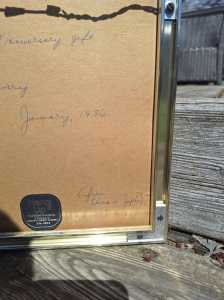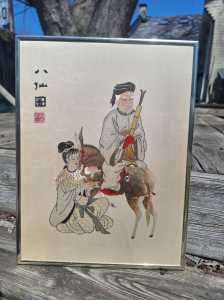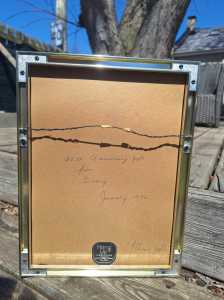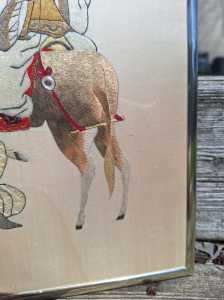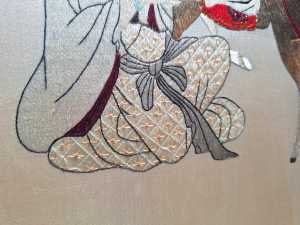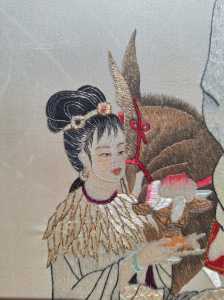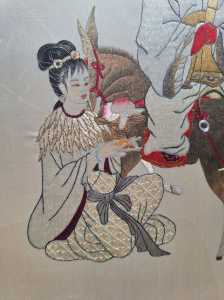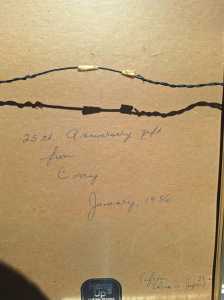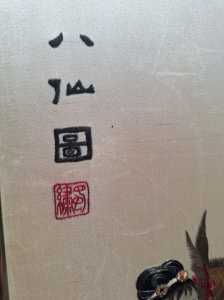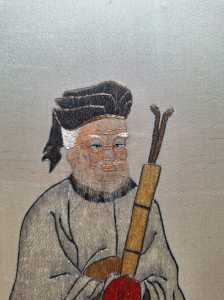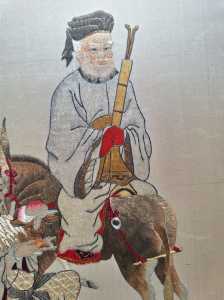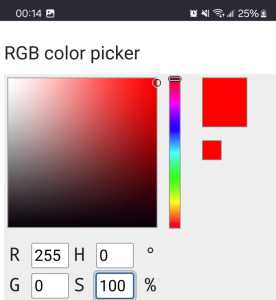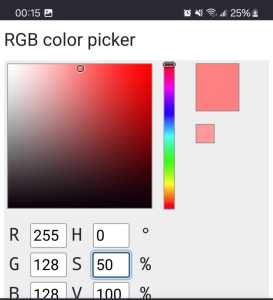The Chinese and Asian Art Forum. For Fans, Collectors and Dealers.
 Basic Rules For the BidAmount Asian Art Forum: Talk about whatever you want. You can even discuss and offer things that are for sale if they are authentic. Maximum image file size per post is 2 MB. Images of 700pxl x 700pxl are optimal if saved at a medium resolution. Be respectful of others and enjoy yourself. Click the YouTube link for a brief tutorial on using the forum. You can also EMBED Videos by cutting and pasting from You-Tube, Vimeo etc.
Basic Rules For the BidAmount Asian Art Forum: Talk about whatever you want. You can even discuss and offer things that are for sale if they are authentic. Maximum image file size per post is 2 MB. Images of 700pxl x 700pxl are optimal if saved at a medium resolution. Be respectful of others and enjoy yourself. Click the YouTube link for a brief tutorial on using the forum. You can also EMBED Videos by cutting and pasting from You-Tube, Vimeo etc.
NOTE: To post an item or add a new post, click open the category title from the FORUM LIST, and CLICK the Blue ADD TOPIC button.
So I have learned that this is a Sichuan Embroidery (portrait? is that a proper term for an embroidery?) depicting two of the Eight Immortals, He Xiangu (the woman kneeling) and Zhang Guolao, the elderly man riding the donkey backwards.
The embroidery seems to be quite detailed.
The strands of the silk used to create the canvas seem somewhat imperfect, implying at least some age to it, correct?
Looks like it got stained or something spilled on it in the bottom left hand corner?
Was this just a souvenir from some airport shop in China from the 80s or is it potentially older than that?
How would I find out? Thanks for looking!
Found in a thrift store in Burlington, Ontario yesterday for $8.99 CAD. It had been sitting on the shelf for 3 days according to the price tag!
A member who has not been active for a few years, but was our resident expert, told me that items with pink do not have great age. Judging by the "custom" frame, which is the same type I used as a student, sold at any art supply house and only requiring the instructions and a screw driver, I believe this embroidery is contemporary with the eighties. It is pretty and appears to have water damage, perhaps a water leak in a wall, but for the price you paid, who cares? Someone may want to disassemble the frame and try to remedy the water discoloration, folk do all types of things to stay busy, but I would test the threads on the back first, to see if they are colorfast.
P.S. I would have bought as well and had fun taking it out of the frame and trying to remove the stain, probably a remedy online. Unless, the fabric is not stable, in which case, I would still remove it from the frame long enough to clean the interior of the frame and the glass and replace backboard with acid free board and an acid free mat could cover part of the stain. You could have a custom mat cut with deeper top and bottom and slender sides or get yourself an exacto knife and cut one yourself. Careful measurements, ruled lines on the reverse, they are not difficult to make, or a Hobby Lobby or such would cut you a mat and not charge as much as s frame shop.
I appreciate your insight and taking a look at my item 🙂
As for the water damage... It looks like that occurred before it was framed as there is no discoloration whatsoever to the thin cheap cardboard backing it is framed on.
Interesting point about pink's not existing in antiquity... Isn't pink just a lighter red? Like a white thread with less red dye... Wouldn't that always be pink?
See screenshots attached with some color theory... Same red with half the saturation makes pink at least I think that's how it works.
Perhaps it was red dyes that were not common in antiquity?
As for the cheap frame... If you read the inscription on the back... Whoever framed it apparently wasn't even sure if it was Chinese or Japanese... Or seemingly new anything about the depictions in the embroidery.
Burlington Ontario is a very wealthy area.
So I'm assuming that they purchased it perhaps from a less knowledgeable antique dealer in the area who themselves wasn't even sure if it was Chinese or Japanese... Unless perhaps these embroideries were very commonly made available for sale in Canada in the 1980s? I wasn't alive then so I would have no idea 🙂
Surely if they purchased it in Asia they would know if it was Chinese or Japanese you would think?
Thanks again 🙂 have a great night Sharon
I just asked chatGPT 4 about the history of pink dyes in China and this is what it said:
The history of pink dyes in China is fascinating and goes back centuries. The development and use of dyes in ancient civilizations were closely linked to the availability of natural resources, and China, with its rich history and biodiversity, had access to a wide range of materials for dyeing fabrics.
Pink dyes, in particular, could be produced from several sources. One of the earliest methods to obtain a pink hue was through the use of plant-based dyes. For example, the madder plant (Rubia tinctorum), which was widely used across the ancient world, including China, could produce a range of colors from pink to deep red, depending on the dyeing process and the mordants used. Madder has been used for textile dyeing in China for thousands of years, with evidence of its use dating back to at least the Han dynasty (206 BCE – 220 CE).
Another source of pink dye in ancient China was the use of insects. The cochineal insect, native to the Americas, produces carminic acid, which can be processed into a vibrant red dye. However, this source of pink and red dyes would not have been available in China until after contact with the Americas was established in the 16th century, following the Spanish conquest of the Aztec Empire. Before the introduction of cochineal, similar insect-based dyes, like those from the Kermes vermilio (a type of scale insect found in the Mediterranean region), could have found their way to China through the Silk Road, but their impact and usage would be less prevalent compared to plant-based dyes.
The precise hue and intensity of the pink color obtained through these natural dyes would vary based on several factors, including the specific materials used, the fabric being dyed, the local water composition, and the dyeing techniques employed. The development of synthetic dyes in the 19th century greatly expanded the range of available colors, including pinks, making them more vivid, durable, and cheaper to produce.
To summarize, while specific dates are hard to pin down due to the nature of archaeological evidence and historical records, it's clear that methods to produce pink dyes from natural sources have been known and used in China for centuries, certainly by the Han dynasty and possibly earlier, through the use of plant-based dyes and, to a lesser extent, insect-based dyes.
Also sorry the last argument that I wanted to make for my piece possibly being older than newer is that apparently Sichuan embroidery prided themselves on double-sided embroidery over the past hundred years... And given the inscription and layout of the image on this particular embroidery I failed to see how it could be mirrored on the back... Also it seems strange to hide the mirrored image on the back of a opaque frame... I will remove it from the frame in due time and let you know what's on the other side 🙂
I agree with Sharon; I feel this is from the second-half of the 20th c, maybe 1960s as the inscription suggests the person writing the note, didn't buy it from new. I think these are more modern threads, they haven't faded at all or run in the water.
I would be interested to see the reverse if you remove it. 😊
It was four years ago, but I found member Tam's reply to help identify my Republic period embroidery, "Yes, I think this dates to the 20s or 30s, and looks to have been embroidered on a woven or damask silk background. The pink silk in some of the clothes and flowers was a chemical (non-natural) dye, which was introduced into China in the 1870s."
It is my opinion that your piece more resembles my embroideries from the last quarter of the 20th century, rather than the first quarter, but by all means continue your quest, bonne chance.
P.S. The older piece actual embroidery work is only 3" x 3.5" and there was never a blind stitch, that old story is apocryphal.
The kitties are much larger actual embroidery work. I also have two 100 children playing embroideries, which I purchased in Beijing in 1992, they are eighties work as well on a dark green silk background, in the late eighties, "jewel tones," were the rage. You were born in a great decade. 😀
Thank you all for your depth of knowledge and insights!
I agree that my embroidery looks very similar in style to the kittens from the 80s there.
The red sichuan embroidery seal looks very different however... both in those examples posted above and the example linked to from ebay below.
The only last few things I can think of that might set mine apart are:
1) This was a 25th anniversary present... from a person who lives in a town mostly filled with millionaires. I don't know what a brand new embroidery made yesterday would cost in the 1980s, but I have a feeling it would be a paltry/insulting sum for a 25th anniversary present? Perhaps they got ripped off by some shady dealer, however.
2) I found a similar kitten embroidery on ebay that claims it's from sichuan in 1984, see https://www.ebay.co.uk/itm/315209648256?itmprp=cksum%3A3152096482562ad60b5444614aac8f4be8bfbe14c8de%7Cenc%3AAQAJAAAA8NRzVC2W1YTkflpzYTzZo05BG1ytOezFlp00x4LMT8StlG7jxDjr8T7OVH3CBj30kN2oVt3ff8PE%252F0Rw2RhQ5Muo3du%252BeT3cRoVvjIkPiodG5oQl6Igye88MgTpbE17Y9hKztUmB033jAtK8aXCbOcl51Ou7bBAUq8Iry2YHW8%252FuS0s05hw1FeKipFtBYMWWlZKAlS%252BvJhcBRBbGAGaGajC3YlU2XPzvBy%252BuLjuWIg62%252FsVGthXSHJVMsTQIUkoeGphzn7KIIN%252B7hqV0FmbWnaGiRg9H29ooqmEKsCkdWShEboKnlwjkBxm4JtT4FGFbMA%253D%253D%7Campid%3APL_CLK%7Cclp%3A4429486&itmmeta=01HV08DXJVVG7ZJJG1QMGAW298 ... The homogeneous nature of the canvas seems much different in that example than in mine. Mine has various imperfectly white threads weaved directly into the canvas backing.
3) As to "I think these are more modern threads, they haven't faded at all or run in the water. " ... I know nothing of chinese silk dying but I would assume that water would be ineffective in making the dyes run? Did the emporers never wash their clothes? Or did they just only ever wear new clothing like princess Diana? 😛
Are there any good books or resources on the matter?
Not saying I don't believe your expertise!
I truly appreciate it!
I also am in the process of buying my first house and am thus in dire need of being extremely hopeful that this is older than you think it is LOL 😛
I am also simply really curious to learn as much as I can 🙂
I tried looking for some of peter's videos on textiles and could only find this one titled "Chinese Silk, Fine Robes of the ming and qing dynasty and who wore them"
I appreciate your thinking that the 80s was a great decade lol... so I have heard! Unfortunately I do not remember much of it 😛
Thanks again =D
Hello Johnny Apple
one first thing you need to know is it hand made or machine made. My eyes are not as good as they used to be but to me it looks hand done. Plus they left an old wire hanger and a newer wire when they refrained it I have some old painting and early prints with the same wire from early twenty century. The writing on it says eight immortals here is some sites that might help John S.
https://www.suembroidery.com/chinese-silk-hand-embroidery-vs-machine-embroidery
https://resources.made-in-china.com/article/culture-life/eQnEaFpxBmHh/Sichuan-Embroidery/
Thanks for visiting "The BidAmount Asian Art Forum | Chinese Art"
If you sell on eBay, or have a shop feel free to post images and descriptions and links.
Check back often for discussion about the latest news in the Chinese art and antique world. Also find out about the latest Asian art auctions at Sotheby's, Christie's, Bonhams and Tajans.
Auction results for: fine porcelain, ceramics, bronze, jade, textiles and scholar's objects. As well as Japanese, Thai, Vietnamese and other Asian cultures.
Thank you,
Peter Combs
Topics and categories on The BidAmount Asian Art Forum | Chinese Art
Kangxi vases, Kangxi dishes and chargers, Kangxi ritual pieces, Kangxi scholar's objects, Qianlong famille rose, Qianlong enamels, Qianlong period paintings, Qianlong Emporer's court, Fine porcelain of the Yongzheng period. Chinese imperial art, Ming porcelain including Jiajing, Wanli, Xuande, Chenghua as well as Ming jades and bronzes.
The BidAmount Asian Art Forum | Chinese Art
A free Asian art discussion board and Asian art message board for dealers and collectors of art and antiques from China, Japan, Korea, Thailand, Cambodia, Vietnam and the rest of Asia. Linked to all of the BidAmount Asian art reference areas, with videos from plcombs Asian Art and Bidamount on YouTube. Sign up also for the weekly BidAmount newsletter and catalogs of active eBay listing of Chinese porcelain, bronze, jades, robes, and paintings.
The art of calligraphy - and for the ancient Chinese it certainly was an art - aimed to demonstrate superior control and skill using brush and ink. Calligraphy established itself as one of the major Chinese art forms during the Han dynasty (206 BCE - 220 CE), and for two millennia after, all educated men were expected to be proficient at it.
The Museum’s collections of Asian art span nearly five millennia and encompass the cultures of China, the Himalayas, India, Japan, Korea, and Southeast Asia. In 2007, the Museum launched an initiative to create dedicated galleries for the collection, beginning with a gallery for the arts of Korea ...
Chinese art is full of symbolism, in that artists typically seek to depict some aspect of a totality of which they are intuitively aware.
China Online Museum is the finest online museum of Chinese art. It features Chinese calligraphy, painting, ceramics, bronzes, carving, and other artworks.
Chinese Ceramics & Works of Art. Overview Upcoming auctions Contacts Auction results ... Christie’s sales of Chinese ceramics and works of art showcase centuries of Chinese history. Held throughout the year in London, New York, Paris and Hong Kong, they attract a wide audience of collectors and connoisseurs vying for pieces as diverse as ...
Explore Asian Art Week. Contact the Specialist Department. Chinese Paintings ... Senior Specialist, Head of Sale. [email protected]. Tel:+1 212 641 5760. Bid in-person or online for the upcoming auction:Fine Chinese Paintings on 10 September 2019 at New York. Bid in-person or online for the upcoming auction:Fine Chinese Paintings on 10 ...
Discover an abundance of must-see art from all corners of a vast continent at Christie’s NY Asian Art Week. From contemporary classical and Chinese paintings to works with exemplary provenance from the Art Institute of Chicago, our Rockefeller Paza galleries will be full of ancient treasures and contemporary masterworks in a salute to the vibrant arts of Asia.
Sold to benefit The Art Institute of Chicago’s Asian Art Acquisition Fund, the sale features 84 lots with a focus on Ming and Qing porcelains, and offers a rare insight into the taste for collecting Chinese ceramics and works of art in the Midwest from the end of the 19th century through the 1980s. Highlights include two Wanli wucai garlic-head vases, a Qianlong mark and period, blue and ...
Specialist, Chinese Paintings, Christie's London Dr Malcolm McNeill is a Specialist in Chinese Paintings at Christie’s, based in London. He previously worked as an assistant curator of the Chinese collections and the Victoria and Albert Museum in London, as a researcher at the British Museum, and as a translator and tour guide at the National Palace Museum in Taipei.
The Christie's Education 2020 Conference: The Chinese Art Market 18 Jun 2019 Christie’s Education is delighted to announce our first international academic conference in Asia which will take place in Hong Kong from 26-27 November 2020 at the Hong Kong Convention and Exhibition Centre and will run in parallel with Christie’s Hong Kong Autumn Auctions.
The summer Chinese Art sale in Hong Kong will feature works of art from several private collections, including Qing porcelains and textile from the collection of the legendary Chinese art dealer A. W. Bahr (1877–1959), fine gilt bronze Buddhist sculptures from an old Hong Kong collection, an East Asian collection of Qing dynasty wine cups and jades, and a Japanese collection of Song ceramics ...
Sotheby's Chinese Works of Art Department holds two auctions each year in London, New York, Hong Kong and Paris.
Chinese Art - View Auction details, bid, buy and collect the various artworks at Sothebys Art Auction House.
With more than 340 Chinese works of art dating from the Neolithic to the Republic periods, highlights of this sale include a selection of Qing Imperial monochromes from the collection of Arnold and Blema Steinberg, early ceramics from the Art Institute of Chicago and Chinese porcelain and works of art from the collection of Henry Arnhold.
Results: Sotheby's Asia Week achieved $52.4 million in six strong auctions, exceeding pre-sale estimates. With 76.5% of lots sold and 60.3% of lots surpassing high estimates, the Asian art sales at Sotheby's indicate continued collector interest in the finest works of art from China, India and and the Himalayas.
Today's sale of Important Chinese Art will proceed as planned with sessions at 10 AM and 2 PM EDT. Sotheby's will be monitoring the weather conditions throughout the day and will be available to coordinate alternative bidding options should conditions make it difficult for clients to attend the auction in person.
Bonhams Chinese Art department is renowned for offering the finest works of art representing the richness and breadth of China's artistic heritage, particularly Imperial porcelain, white and spinach green jades, cloisonné and Buddhist art. Specialised international auctions are held globally, including London, Hong Kong and San Francisco.
Bonhams : Chinese Works of Art We use cookies to remember choices you make on functionality and personal features to enhance your experience to our site. By continuing to use our site you consent to the use of cookies. Please refer to our privacy and cookie policies for more information.
Bonhams Fine Art Auctioneers & Valuers: auctioneers of art, pictures, collectables and motor cars. We use cookies to remember choices you make on functionality and personal features to enhance your experience to our site. By continuing to use our site you consent to the use of cookies. ... Chinese Art (US) General enquiries
Bonhams : Fine Chinese Art We use cookies to remember choices you make on functionality and personal features to enhance your experience to our site. By continuing to use our site you consent to the use of cookies. Please refer to our privacy and cookie policies for more information.
Bonhams Fine Art Auctioneers & Valuers: auctioneers of art, pictures, collectables and motor cars Bonhams : Asian Art We use cookies to remember choices you make on functionality and personal features to enhance your experience to our site.
Bonhams are international auctioneers of fine Chinese and Japanese art. We specialise in rare Imperial and Export Chinese ceramics and works of art, as well as Japanese ceramics, fine and decorative works of art from the Neolithic Period to the 20th century. View on map
Bonhams Fine Art Auctioneers & Valuers: auctioneers of art, pictures, collectables and motor cars. We use cookies to remember choices you make on functionality and personal features to enhance your experience to our site. By continuing to use our site you consent to the use of cookies. ... Asian Art Bonhams. Work. 22 Queen St.
